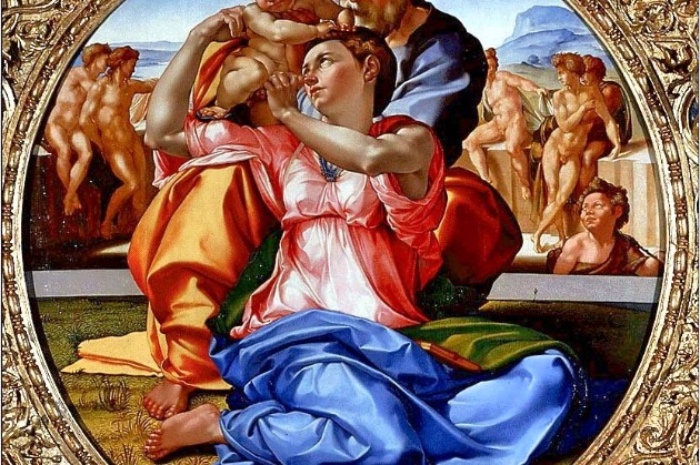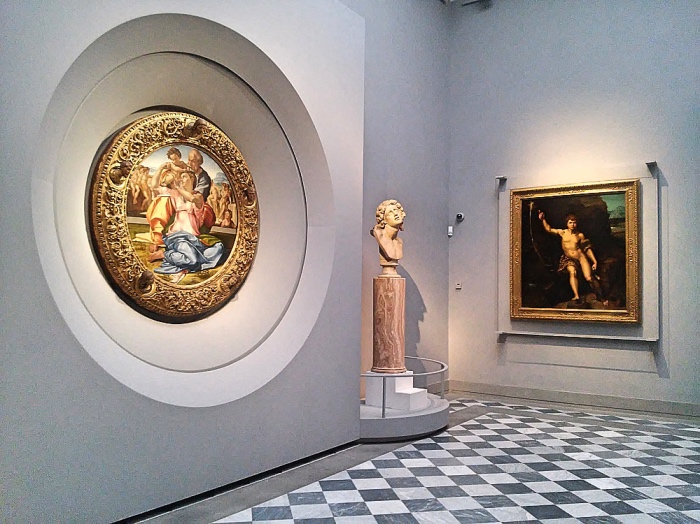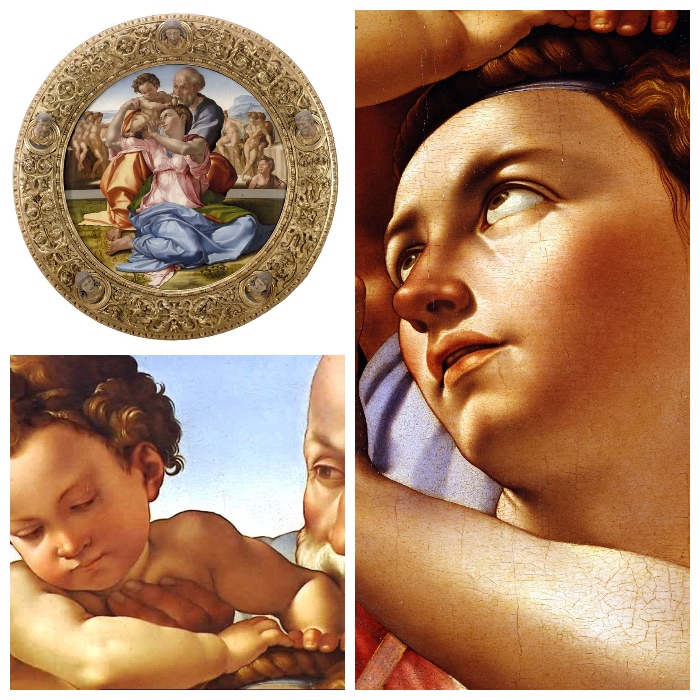
THE DONI TONDO BY MICHELANGELO: WHERE IT IS HOUSED AND WHAT IT REPRESENTS
Admiring for the first time The Doni Tondo by Michelangelo Buonarroti was thrilling. I was at the Uffizi Gallery for the traditional high school trip and when I came across it, I understood that art must be experienced at first hand. You must close the books and leave to admire art where you can admire it!
After a feeling of wonder,I wanted to know everything about this masterpiece, and after writing the post dedicated to Michelangelo’s David, it was time to talk about Buonarroti’s most amazing painting.
The Doni Tondo by Michelangelo: where it is housed and what it represents

The Doni Tondo at the Uffizi Gallery.
After the sculpture of David, a new masterpiece came from Michelangelo’s mind and hands, but this time is a painting, the Doni Tondo.
The work was commissioned by Agnolo Doni, who wanted a representation of the Holy Family.
THE DONI TONDO BY MICHELANGELO: WHAT IT REPRESENTS
We don’t know on which occasion the painting was made. Maybe on the occasion of the marriage between Agnolo Doni and Maddalena Strozzi, whose coat of arms appears on the frame, or the birth of their daughter Maria in 1507.
However, Michelangelo painted a Holy Family in which the figures look like sculptures, the colours are gaudy and the twisting of the bodies will inspire future generations of artists, up to the present day.
The beauty and the importance of this painting lie in the central part where Mary, Joseph and the child Jesus are like a sculpture group. Behind them you can see Saint John the Baptist, and in the background the young nude figures which foreshadow the sculptures of the Prisoners for the tomb of Pope Julius II.
To Michelangelo the best painting was that similar to sculpture, there’ s no doubt about it!
READ ALSO – Michelangelo Buonarroti: 5 things to know
THE DONI TONDO BY MICHELANGELO: CURIOSITIES
But you know that I do love stories illustrating artworks and the Doni Tondo by Michelangelo has a marvellous story which is worth knowing.
When the painting was finished Michelangelo gave it to Agnolo Doni, who didn’ t want to pay the agreed-upon amount.
Let’s say that he wanted a small discount!
Doni was a merchant and believed that he could fetch a lower price. But, obviously, he didn’ t know who he was dealing with, or underestimated Michelangelo’s pride, who, in fact, meant the fact that the patron didn’ t want to pay the full amount as a personal insult.
So, the artist got the painting back and brought to his home, telling Agnolo Doni that the price had changed and he had to pay double for it.
The only thing the merchant could do was pay, and so he neither got a discount nor a good bargain. He had to pay the double amount!
This is the first recorded case of an artist opposing his patron and demanding not only his payment but also putting himself in a higher position and treating the merchant as a “client”.
Michelangelo was a great artist even in this situation and changed the market rules.
THE DONI TONDO BY MICHELANGELO: WHERE IT IS HOUSED
The Doni Tondo by Michelangelo is housed and on display in the Uffizi Gallery in Florence, and is still in its original frame, which is a very rare thing in so ancient masterpieces, and it has been assumed that it was carved following a drawing made by Michelangelo himself.
It’ s a refined frame containing, among decorations and leaves, the coat of arms of the Strozzi family and heads of Christ, angels and prophets.
READ ALSO – The Uffizi Gallery: works, tickets, history and everything you should know

READ ALSO – Michelangelo’s works: which ones they are


Gentilissima Signora Caterina,
ho apprezzato molto il Suo modo di “raccontare” questa bellissima storia artistica.
Ne trarrò spunto per la presentazione che dovrò esporre alla mia Professoressa.
Grazie ancora sia da parte mia che della mia mamma.
Cari Saluti
Viola Angeli
Sono felice di esserti stata utile. In bocca la lupo per la presentazione 😉
Ho appena letto la sua interpretazione. Io credo che il significato del tondo sia ben altro. Rappresenta l’amore familiare fra maschio e femmina creatore di nuova vita in contrapposizione al gruppo di giovani maschi sullo sfondo: i sodomiti alias gli odierni omosessuali. Maria sta tra le gambe aperte di Giuseppe mentre accarezza i genitali del bambino quasi a proteggerli dalla diffusione del peccato di Sodoma contro cui si era scagliato Savonarola e per questo finito sul rogo nel maggio del 1498.
Mi sembra un po’ forzata questa lettura anche perchè dà per scontato che Michelangelo ragionasse come un uomo del XXI secolo.
Michelangelo era profondamente cattolico e non avrebbe mai inserito un concetto del genere in una sacra conversazione e non credo neppure che Agnolo Doni volesse esporre nella sua residenza un’opera con questo significato. All’epoca il committente e l’artista si mettevano preventivamente d’accordo sul tipo di opera da realizzare e anche sul soggetto da rappresentare
Non dimentichiamo, inoltre, che Michelangelo entrò a fare parte del gruppo degli “spirituali”, un gruppo elitario di riformisti moderati che aspirava alla pace tra i cristiani e al ritorno allo spirito evangelico. Era molto attento al messaggio spirituale delle sue opere e la lettura che proponi presuppone che Michelangelo stesse facendo un atto di denuncia.
Come del XXI secolo? Michelangelo era presente alle prediche di Savonarola e dopo quella del 21 settembre 1494 che preannunciava come imminente il castigo di Dio sulla sodomitica Firenze, scappa dalla paura a Venezia. La questione degli spirituali poi è assai più tardiva e più che cattolico Michelangelo era un credente conoscitore della sacra scrittura. Tutte le sue opere, ripeto tutte le sue opere guardano a Savonarola di cui era un devoto seguace. Da venticinque anni studio Michelangelo e non puoi immaginare cosa c’è nella cappella sistina, nella Pietà vaticana e nel Davide!